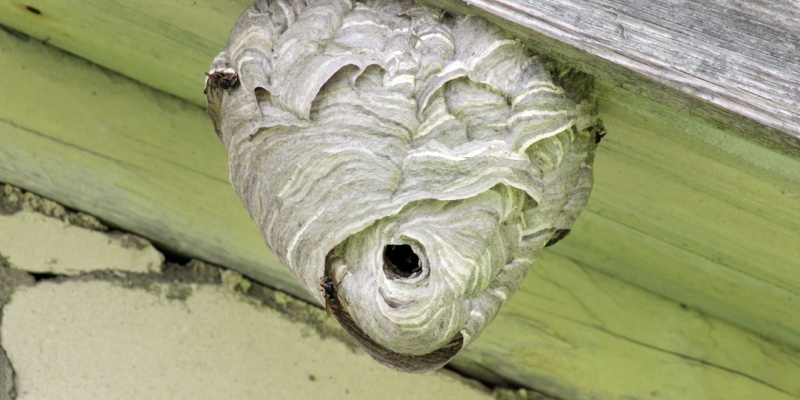In North Port’s warm climate, stinging insects find our homes to be perfect real estate for building their nests. Eaves, soffits, and outdoor structures like sheds offer the ideal combination of shelter, protection from predators, and proximity to food sources. Unfortunately, nests in these locations pose significant risks to homeowners and their families. Learning to identify signs of nesting activity and taking proactive prevention measures can help keep your property sting-free.
Common Nesting Locations Around Your Property
Eaves and Overhangs
The eaves of your home provide stinging insects with sheltered, protected locations for their nests. Paper wasps particularly favor these areas, building their distinctive umbrella-shaped nests from a paper-like material created by mixing wood fibers with their saliva. These nests often appear in corners where walls meet ceilings, providing maximum protection from the elements.
Soffits and Fascia Boards
Soffits—the underside of roof overhangs—are another prime location for stinging insect nests. Any gaps or damaged areas in your soffits can allow wasps and hornets to access the space between your roof and home’s exterior walls. Once inside these voids, colonies can grow to substantial sizes before you even realize they’re there. Yellow jackets commonly establish nests in these areas, potentially causing structural damage over time.
Sheds and Outbuildings
Garden sheds, detached garages, and other outbuildings provide ideal nesting locations due to their lower human traffic. Hornets and wasps particularly favor the rafters, corners, and sheltered areas of these structures. In North Port, it’s common to find nests forming in rarely accessed areas like storage sheds, where they can develop undisturbed for extended periods.
Other Hotspots
Beyond these primary locations, stinging insects also commonly build nests in:
- Under deck railings and furniture
- Inside gas grills and outdoor equipment
- Behind window shutters and blinds
- Around play structures and treehouses
- Near porch lights (attracted by insects)
Signs That Stinging Insects Have Moved In
Visual Indicators
The most obvious sign of a stinging insect infestation is seeing the insects themselves regularly flying to and from a specific area of your home. You might notice increased wasp or hornet activity around your eaves, soffits, or shed entrances. Pay special attention to insects that seem to be disappearing into small holes or cracks—this often indicates an established nest within.
Physical Evidence
Different stinging insects create distinctive nests:
- Paper wasps build open-celled, umbrella-shaped nests
- Yellow jackets create enclosed nests with papery shells
- Mud daubers construct tube-like structures from mud
- Hornets build large, football-shaped paper nests
Regular inspections of your property, especially during spring and early summer when new nests are being established, can help you catch these problems early.
Prevention Strategies
Seal Entry Points
Inspect your home’s exterior for potential entry points and seal them:
- Caulk gaps around windows and door frames
- Repair damaged soffits and eaves
- Install fine mesh screening over vents
- Fill holes in exterior walls
Create a Deterrent Environment
Make your property less attractive to stinging insects:
- Keep outdoor eating areas clean
- Secure trash can lids tightly
- Store pet food indoors
- Minimize flowering plants near your home’s entry points
- Reduce outdoor lighting that attracts insects (which attract wasps)
Regular Maintenance
Preventative maintenance can significantly reduce your risk:
- Conduct monthly inspections of eaves, soffits, and sheds
- Remove abandoned nests (safely, during winter months)
- Trim vegetation away from your home’s exterior
- Clean gutters regularly to prevent standing water
When to Call F2 Exterminators
While very small, newly formed nests might be manageable for homeowners to remove with proper precautions, most stinging insect situations warrant professional intervention, especially when:
- The nest is larger than a tennis ball
- Multiple nests are discovered
- The nest location is difficult to access
- You or family members have allergies to insect stings
- The nest is in an area with high traffic (near doors, walkways)
- The colony appears aggressive when approached
F2 Exterminators has the proper protective equipment and specialized treatments to safely remove stinging insect nests from your North Port home. Our technicians can also provide targeted prevention treatments for areas that frequently attract nests, such as eaves and soffits.
Don’t risk painful stings or allergic reactions by attempting to remove established nests yourself. Contact F2 Exterminators today for a comprehensive inspection of your property and professional removal of any stinging insect nests threatening your home and family’s safety.
